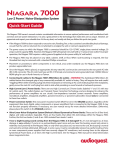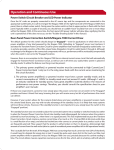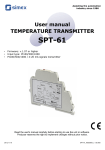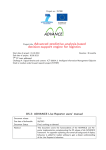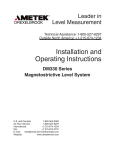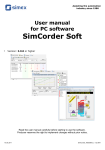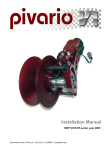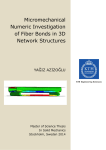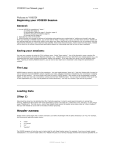Download Magnetic Nondestructive Testing
Transcript
List of contents Barkhausen effect meter type MEB-2c User manual 2.1. 2.2. 2.3. 2.4. 2.5. 2.6. 2.7. 2.8. 2000 “Mag-Lab” 1. Basic features of the meter 2. Main specifications of the meter s.c. Magnetic NDT POLAND 80-335 Gdańsk ul. Sztormowa 1A/6 tel/fax (48 58) 557 82 44 3 5 5 Magnetisation conditions Measurements of Barkhausen effect intensity 5 Measurement of magnetisation control parameter 6 Measurement rate 6 Temperature range 6 Power consumption 6 Dimensions 6 Meter ensemble specification 7 3. Background of the Barkhausen effect 4. Meter structure and its operating 4.1. Meter structure 4.2. Meter control points and plugs 4.3. Work with meter 4.3.1 Installation and start operating the meter 4.3.2. Measurement of the v1 parameter 4.3.3. Measurement of the x parameter 4.3.4. Measurement of the counter parameter 4.3.5. Measurement of the v2 parameter 4.3.5. Accumulator and ‘charger’ unit service 4.3.6. Data transfer Figures 8 10 10 12 14 14 14 15 15 16 17 18 1. Basic features of the meter The MEB-2c meter it is a fully portable low power consumption measuring set designed mainly for in field fast two-parameter measurements of the Barkhausen effect intensity with control of magnetisation conditions. The Barkhausen effect intensity depends on two factors: microstructure as well on the mechanical stress level (external or residual). The MEB-2c meter can be used for evaluation of both these factors, respectively. The MEB-2c meter includes the probe to activate and to detect Barkhausen effect signal from a sample and the central unit to supply the probe, to process, display and send to external PC the data. The central unit includes the analogue part for input voltage waveform processing and the digital part with microprocessor system that controls the analogue to digital conversion of signals, the output data visualisation with LED screen and communication with external digital systems by means of the RS232 port. The probe of MEB-2c meter contains magnetising electromagnet type C and two sensors: ferrite core with pick-up coil (A) for the Barkhausen effect detection and reference pick-up coil (B) wounded on the magnet core for magnetisation process control, respectively. Voltage of Barkhausen effect from pick-up coil (A) is filtered, amplified and analysed by analogue part and then by digital part. The MEB-2c meter provides values of two parameters that are related to the Barkhausen effect intensity over one period of magnetisation: 3 - v1 - voltage Us proportional to effective intensity of the Barkhausen effect waveform; - counter - number Nc related to the number of Barkhausen effect pulses. The number of pulses depends on the voltage threshold which can be selected by user in order to achieve the highest resolution of BE inspection . The MEB-2c meter makes also subtraction from the parameter v1 of its value measured at chosen reference point and stored by meter. The resulting difference (parameter x) depicts thus the relative change of the Barkhausen effect intensity. This option allows to perform quick evaluation of differences of or magnetic properties or stress level over the tested material. Voltage from the reference pick-up coil (B) is analysed by central unit in order to detect the parameter v2 - the amplitude of voltage value Uc that is proportional to maximal level of magnetic flux derivative in the magnetising core. This parameter can be used in order to optimise the probe position against the sample as well to evaluate the magnetic properties of the sample. The three parameters (v1 (or x), counter and v2) are displayed with the LCD screen and also transferred to the RS232 port. User can tune the gain of the Barkhausen effect voltage amplifier and threshold level of the Barkhausen effect pulses analyser. 4 2. Main specifications of the meter 2.1. Magnetisation conditions Magnetisation current - driving a magnet core - has triangular waveform with frequency of about 25 Hz and amplitude of about 100 mA. 2.2. Measurements of Barkhausen effect intensity A. Amplifier gain variation Gain can be varied in range from 0 up to 50 dB with 1 dB resolution. B. Parameter v1 (effective intensity of the BE) Range of measurement with LCD screen: 0 ÷ 1023 mV. C. Parameter x (differential mode of v1 measurement) Parameter x it is the difference between actual and reference value of v1. Range of x measurement with LCD screen: 0 ÷ 1023 mV. D. Parameter counter (number Nc of Barkhausen pulses within a 25 periods) Range of counter measurement with LCD screen : 0 ÷ 65536. Number of pulses depends on threshold level. This level is tuned in range from 0 up to 9 (in arbitrary units). 5 2.3. Measurement of magnetisation control parameter Parameter v2 depicts the amplitude of magnetic flux derivative in the magnetising core. Range of the v2 parameter measurement with LCD screen: 0-1023 mV. 2.4. Measurement rate Magnetisation frequency and signal processing rate are permanents. The values of three parameters are provided to the LCD screen and to the RS232 port with frequency of about 1 Hz. 2.5. Temperature range Central unit: from 0 oC to +40 oC. Lower limit is due to applied LCD screen Probe: from -20 oC to +40 oC. 2.6. Power consumption Power consumption: maximal - 3.6 W (with LCD back light ON) and minimal - 2.9 W (with LCD back light OFF).Time of work with accumulator (Ni-Cd; 2400 mAh) : of about 4 hours. Alimentation by external power pack: 220V/50 Hz or 120V/60 Hz. 2.7. Dimensions A. Central unit: height - 70 mm, width: 145 mm, length: 52 mm; weight - about 1000 G B. Probe (type MEB-2c2): height - 48 mm, width: 21 mm, length: 32 mm; cable length: about 1.5 m. 6 2.8. Meter ensemble specification - measuring unit, - probe with cable - charger - external power pack - transformer - user manual - software for data storage with PC - metallic case. 3. Background of the Barkhausen effect The Barkhausen effect (BE) is related to the abrupt change of magnetic domain wall (DW) position in the ferromagnetic body subjected to the change of external magnetic field strength. Such jump, producing abrupt changes in local magnetisation, can be detected by means of a voltage pulse induced in a pick-up coil placed near the sample surface. The voltage signal of BE as induced for magnetisation frequency or order of Hz, has a frequency spectrum from magnetising frequency up to 300 kHz. The electromagnetic waves generated by BE jump are attenuated by conducting material due to eddy currents and this determines the depth of layer of about 1 mm from which an information about the BE events can be obtained. Intensity of the BE depicts hysteresis process due to local defects and thus depends mainly on microstructure of the material. The BE intensity maximum peaks at the magnetic field strength close to the coercitvity field Hc. The height of this maximum is lower for the magnetically hard materials than for the magnetically soft materials. Such dependence of BE intensity is used for nondestructive evaluation of magnetic properties of tested material. The mechanical stress applied to the ferromagnetic material with nonzero magnetostriction parameter has an effect on the BE intensity. 8 7 For materials with positive magnetostriction (case of most ferromagnetic steels), tensile stress increases volume of magnetic domains with magnetisation vector ax parallel to the stress ax. Compressive stress leads to increase of magnetic domain volume with magnetisation vector perpendicular to the load ax. Thus tensile stress increases and compressive stress decreases a surface of DW population which perform the BE jumps at given field strength during cycling. It leads to increase or decrease of BE intensity in function of tensile or compressive stress, respectively. The mostly monotonous dependence of the BE intensity on stress has made it a tool for nondestructive evaluation of the residual stress, too. The BE intensity and it dependence on stress is strongly specific for a given material. It makes evident that calibration procedures are necessary for application of BE for NDE purpose. 9 4. Meter structure and its operating 4.1. Meter structure Block diagram of MEB-2c meter is shown in Fig. 1. There are presented three main parts: probe, central unit and external power source (charger - C, power pack - S and transformer - T). The Barkhausen effect (BE) probe (G in Fig. 1) contains a C-core with a primary driving coil magnetising the specimen (output s1 of central unit) and a secondary reference coil (input s3 of central unit) detecting the magnetic flux changes. The C-core has high permeability and low hysteresis loss. The poles of the magnet are rounded in order to fit the poles to curved surfaces. The BE is detected with a sensor coil which is positioned halfway between the pole pieces. This sensor coil has movable ferrite core, which is pressed by a spring to contact the specimen surface. The voltage induced in sensor coil is at first amplified with a primary amplifier (within the probe box) and then provided to the central unit (input s2 of central unit). The central unit of MEB-2c meter is powered by internal power block (BZ) including the accumulator and voltage stabilisation system. The external power source is used for accumulator service (charging and discharging) and for powering directly to central unit. The magnetisation current (s1) is provided to the probe (G) with the current generator (GM). 10 The BE voltage (s2) from probe (G) is amplified by amplifier (K1). Its gain can be tuned with switches P1 and P2. The output voltage of K1 is analysed by block UA. The UA block contains two parts: 1 - an ac to dc converter with RMS like system providing output signal Us and 2 – the Barkhausen effect pulses analyser with the BE pulse amplitude discriminator, providing output standard signal Up when pulse amplitude is higher then threshold voltage level. Discrimination is tuned with switch P3 that changes the threshold voltage (provided by block UR). The control signal (s3) from probe G is proportional to the magnetic flux derivative in the magnetising core. This signal is analysed by block K2. The output voltage Uc from this block is proportional to the amplitude of the envelope of the reference signal s3. The main part of central unit of MEB-2c it is the microprocessor unit (UC). The UC unit acquires the signals from the BE signal analyser (UA) and from block K2, drives the LCD screen and transfers data to the RS232 port (RS). The UC unit makes analogue to digital conversion of signals Us and Uc from UA and counts the BE pulses Up. This unit evaluates in real time the values of three parameters: parameter V1 – related to the voltage Us (effective intensity of the BE), parameter v2 related to voltage Uc (flux derivative) and parameter counter – related to signal Up (number Nc of the BE pulses). The UC block makes also subtraction from the parameter v1 of the reference value recorded in the UC memory. The resulting difference signal (parameter x) replaces the v1 parameter on the LCD screen. This option is switched to ON or to OFF with switches P5 and P6, respectively. The data from RS232 port can be transmitted to any type of PC (IBM compatible) using software provided by Mag-Lab. Three parameters (counter, v1 (or x) and v2 are displayed on LCD screen. The back light option of screen can be switched with W2 using ON or OFF buttons. Using switch P4 (option INFO) one can display short information about MEB-2c meter serial number and Mag-Lab Company address. 4.2. Meter control points and plugs Fig. 2 shows the front panel and Fig. 3 depicts the back panel of the MEB-2c meter, respectively. The red labels in these figures refer to the parts of blockdiagram as shown in Fig. 1. Front Panel Button W1 (MAIN) switches ON or OFF the power to the meter from the internal accumulator. Button W2 (BL) switches ON or OF the back light to the LCD screen. 11 LCD screen shows values of the 12 following parameters: 1) counter – number of the BE pulses, 2) v1 – effective intensity of the BE voltage or – optionally – x – difference between actual and memorised value of v1, 3) v2 – magnetisation process control signal. Button P4 switches the INFO option to the LCD screen. Second press on this button switch off this INFO from the screen. Button P5 switches ON the option when the x parameter is shown against the v1 Button P6 switches OFF the ‘x parameter’ option, the v1 is shown again. Three switches (P1, P2, and P3) have double knobs system to decrease (upper) and increase (bottom) their state within the range from 0 to 9. Switches P1 and P2 are used for setting of the amplifier gain. Switch P3 increases the threshold voltage level for the BE pulse counter. Back Panel Input G1 is used for probe (G). Input G2 is used for + 7.2 V dc voltage from external power source (positive voltage on the external side of plug!). Output G3 is for data transfer with RS232 Input G4 connects to the accumulator and is 13 used for its charge and for discharge, respectively. (positive voltage on central pine of plug). 4.3. Work with meter 4.3.1. Installation and start operating the meter The meter is ready for use within a time of about few seconds from the beginning when probe is plugged into central unit. There is no need of any regulations or corrections of meter parameters. The meter can be supplied with power by external power source using module ‘charger’ and power pack. The probe position should be perpendicular to the surface. This position is controlled by means of parameter v2 and counter level check. The optimal position of the probe is when all readings are maximal. 4.3.2. Measurement of the v1 parameter Counter: 1000 v1: 500 v2: 600 The v1 parameter depicts effective intensity of the BE. Its level depends on the gain of BE signal amplifier selected with switches P1 and P2 (see Fig.1, K1). It is recommended to set the v1 parameter value close to one half of measuring range – e.g. level v1 = 500. 14 4.3.2. Measurement of the x parameter Counter: 1000 x: +200 v2: 600 The MEB-2c meter allows measurements of parameter x which provides a difference between actual level of v1 parameter and its stored value. The reference value of v1 parameter is stored each time in meter memory when reference mod UR is set on with switch P5. The x parameter allows to perform inspection of BE intensity variation against reference level evaluated at given place. It can be also used for quick detection of areas with positive or negative stress, respectively. Switch to standard mode when v1 parameter is shown on screen is made with button P6. 4.3.3. Measurement of the counter parameter Counter: 1000 v1: 500 v2: 600 The counter parameter depicts the number of BE pulses with amplitude higher then given threshold counted within given number of magnetisation periods. Threshold level is tuned with switch P3. It is recommended to set the P3 so that the counter ≈ 1000 for unstressed material and counter ≈ 100 for the highest compressive 15 stress. Attention: The number of counted BE pulses for a given threshold depends on amplifier gain. It makes that gain (switches P1, P2) and threshold (switch P3) should be chosen simultaneously to match recommended levels of parameter v1 and counter. The appropriate levels of gain and threshold can be determined during stress calibration procedure. 4.3.4. Measurement of the v2 parameter Counter: 1000 v1: 500 v2: 600 The v2 parameter depicts level of magnetic flux derivative amplitude in magnetising core. Its level depends thus on probe position, quality of surface as well on permeability of the material in question. That last factor makes, that v2 parameter depends also on stress level: it decreases for compressive and increases for tensile stress, respectively. These dependencies make the v2 parameter suitable mainly for probe position control and also for material quality inspection (together with v1 and counter parameters). 16 standard. 4.3.5. Accumulator and ‘charger’ unit service The accumulator in the MEB-2c meter allows BE measurements in the field during a time of about 4 hours. The level of accumulator capability is not signaled. Its low voltage leads to decrease of LCD screen brightness. The accumulator is charged automatically with ‘charger’ unit. The ‘charger’ unit is plugged to the meter by two cables. Theirs plugs are different in order to protect the meter against wrong connections. Cable called ‘OUT DC 7.2 V’, ended with longer plug, fits the input G2 of the meter. Cable called ‘OUT 11 V’ fits the input G4 of the meter. Accumulator is disconnected from internal power pack when plug is in the G2 and is automatically charged when plug is in G4 input. The Ni-Cd type accumulators , which are applied in meter, should be discharged to ‘zero’ level after some times of charging and fully charged with control of ‘charger’ unit. To start this full ‘discharge’ and ‘charge’ mode , press the ‘discharge’ button on the backside of ‘charger’ unit. Two LED lamps of ‘charger’ unit signalise the actual state of work of this unit: green light for ‘discharge’ state and red light for ‘charge’ state, respectively. The red lamp goes out when accumulator is fully charged. The ‘charger’ unit is powered by external power pack that provides + 12 V dc voltage and current of about 1.5 A. The as delivered power pack needs 220 V on input and so the extra transformer 110/220 (50 VA) is used in order to fit USA 17 4.3.6. Data transfer In order to use RS232 port of the MEB-2c meter for data transfer, connect meter to PC (IBM type) input ‘com2’ with standard RS cable. Data transfer is made with software ‘RS-MEB2c.exe’ which works with DOS and WIN system. Program asks for name of file, where data will be stored. This program allows to make measurements for twodimensional matrix of points. The dimensions of this matrix are set by user when program starts work. Program shows on PC screen actual values of three parameters: counter, v1 and v2. These parameters can be stored in virtual memory with <space> key pressed and then transferred to the file with <z> key pressed. Program is stopped with <k> key pressed. This commend closes also the file. Attention: program does not work when MEB-2c meter is off. Fig. 2. Front panel of MEB-2c: W1 – power switch (MAIN); W2 – back light switch (BL); LCD - screen; P4 – switch INFO; P5 – switch UR ON; P6 - switch UR OFF; P1, P2 – gain switches G [dB]); P3 – threshold voltage switch. Fig. 3. Back panel of MEB-2c: G1 – probe input; G2 – charger input 1; G3 – RS232 output; G4 - charger input 2. 1 G G1 s2 a b 3 b a W2 UA 3 4 2 (Uo) K2 1 UR 2 G2 S LCD T (Up) (Us) 1 3 2 7 UC 4 8 5 6 G3 RS (Uc) GM s1 C BZ 1 s3 G4 W1 P2 K1 P3 a b 2 P1 OFF b ON a P4 P5 ON INFO P6 OFF UR Fig. 1. Block diagram of MEB-2c: G -probe; K1- amplifier of Barkhausen voltage; K2 – amplifier and analyzer of reference signal; BZ – internal supplier; UA - Barkhausen signal analyzer; UR – threshold voltage source; UC – microprocessor unit; GM - current generator; LCD - screen; W1 – power switch; W2 – back light switch; ; P1, P2- gain switches; P3 - threshold voltage switch; P4 – INFO switch; P5 – UR ON switch; P6 – UR OFF switch; C – charger, S - power pack, T - transformer;












